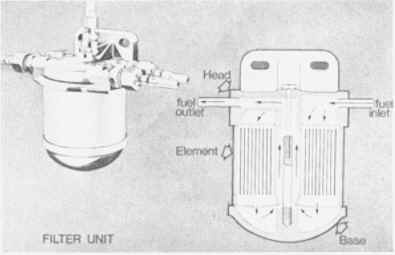FILTER UNIT
Fine particles of abrasive matter and water are often carried in
suspension in the fuel. If these were allowed to pass into the system,
they would cause excessive wear or corrode the precision-finished surfaces
of the metering distributor and pump etc., resulting in poor engine
performance and loss of power. The petrol must be filtered before entering
into the system.
This is done by passing it through a special filter unit, the filter of
which consists of paper strips, wound about a cylindrical core. These
paper strips are cemented together, top and bottom, so as to form a series
of V-shaped coils. The element provides a large filter area (approx. 550
sq.in).
Filter Units (Sectioned) Diagrams
Figure 3 shows the three main components of the
simple filter unit.
1. The filter head, made of cast aluminum. The head incorporates all
fuel connections (inlet and outlet).
2. The base, made of cast aluminum, with centre stud (to accept the
centre bolt of the filter head).
3. The sedimenter element, enclosed in a metal container. The
three components of the filter are held together by means of the centre
bolt, which screws into the centre stud, one end of which is screwed in
the base.
